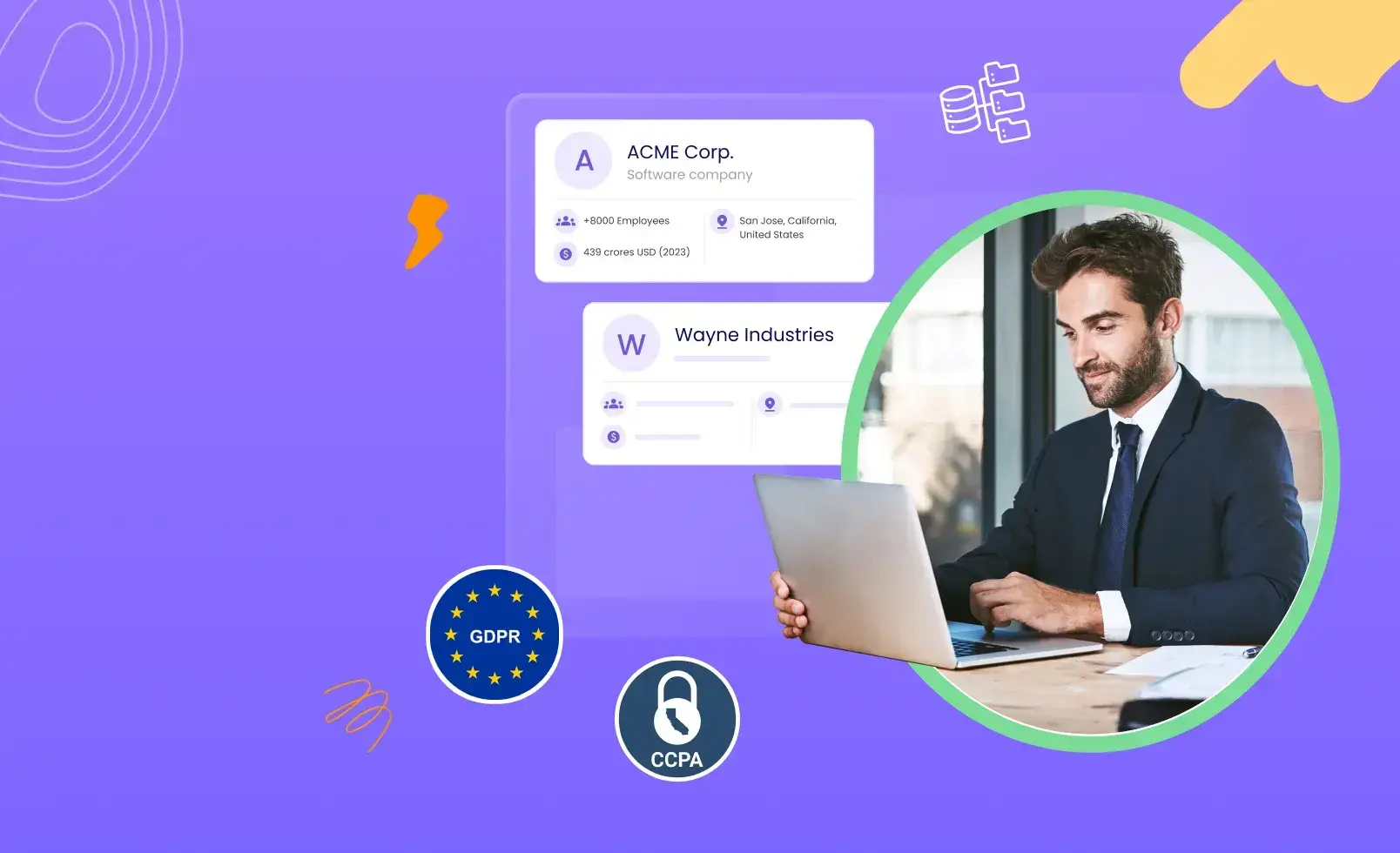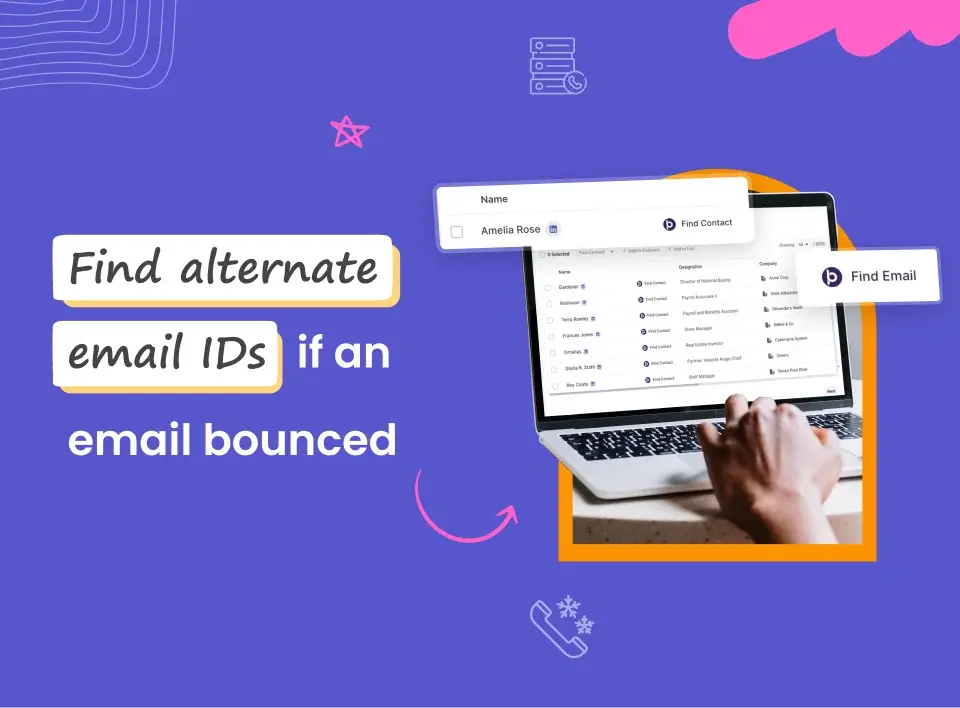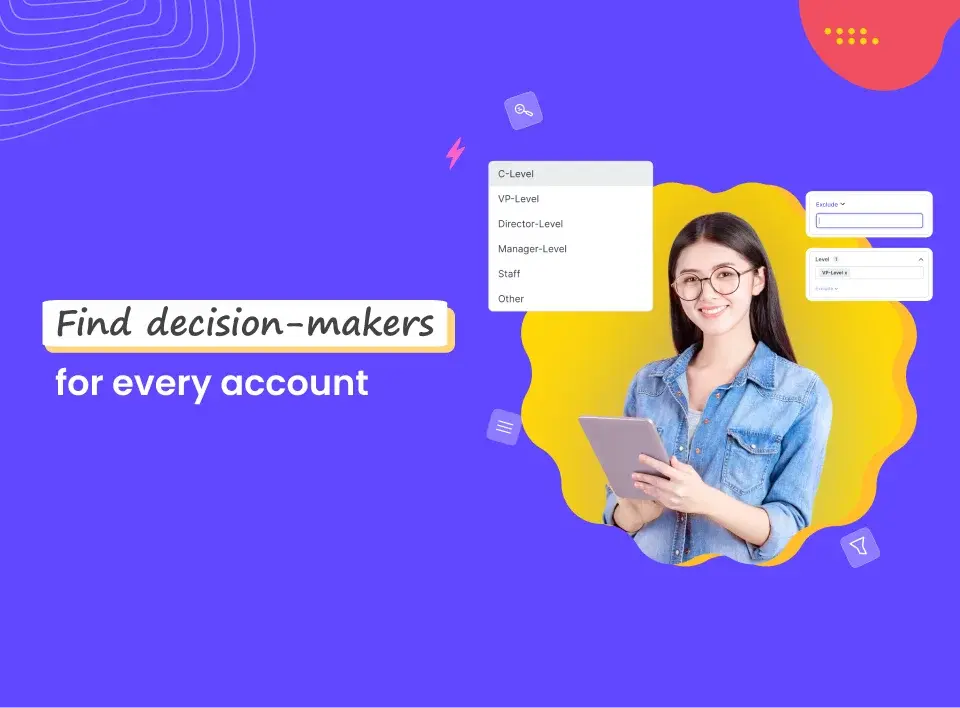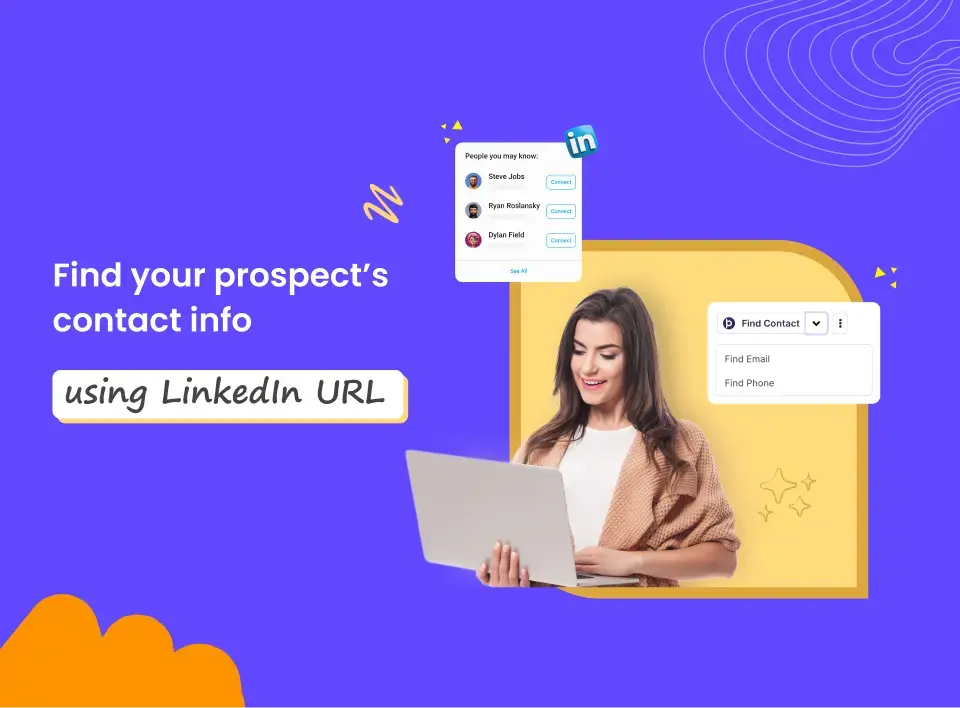Customer data is the most valuable asset for a business—it drives outreach strategies, customer interactions, and decision-making processes.
However, with great data comes great responsibilities. Businesses must navigate the complex space of data protection laws and regulations to ensure they handle data ethically and legally.
Whether you’re a seasoned salesperson or a business owner, it’s important to understand the intricacies of data compliance to build a strong outreach strategy.
This starts with building compliant B2B data lists.
But first…
What Is Compliant B2B Data?
Compliant B2B data refers to the business contact information that is collected, stored, and used in accordance with relevant data protection laws and regulations. Compliance typically involves getting explicit consent from prospects or customers before collecting their data, being transparent about how their data will be used, and allowing them to opt out.
For B2B data, compliance also includes ensuring the data is accurate, up-to-date, and relevant for the intended purpose. Non-compliance with these regulations can result in fines and reputational damage for businesses.
What Are the Different Compliance Laws?
Several compliance laws and regulations govern the use of personal data, and these laws differ from region to region.
Let’s take a look at some of them.
European Union Data Compliance Laws
General Data Protection Regulation (GDPR) applies to all EU member states and regulates the processing of personal data of individuals within the EU. There are two regimes: opt-in allows individuals to consent before receiving an email, whereas opt-out allows unsolicited emails with an unsubscribe option.
United Kingdom Data Compliance Laws
Data Protection Act (2018) supplements the GDPR. In other words, it’s the UK’s implementation of GDPR. Businesses that collect customer data must adhere to strict rules regarding the processing and storing of personal data. Some rules include specified and explicit data usage, data storage only until necessary, and secure data handling.
Privacy and Electronic Communications Regulations (PECR) covers rules relating to e-communication via marketing emails, cookies, and cold calls. It requires businesses to obtain consent before sending emails and states that customers must know how their cookies will be handled on websites.
United States Data Compliance Laws
California Consumer Privacy Act (CCPA) protects the collection and processing of personal data of California residents. It regulates cookies, internet activity, IP addresses and biometric data, and other information collected via IoT devices. Individuals have the right to know what data is collected and how it’s used.
Health Insurance Portability and Accountability Act (HIPAA) regulates the use and disclosure of protected health information (PHI). HIPAA rules apply to certain groups like doctors, insurance companies, and others who handle your health information. These regulations mandate that covered entities comply with individuals' rights to access and correct their health information. Additionally, covered entities are prohibited from using or disclosing health information without the individual's written consent.
The Gramm-Leach-Bliley Act (GLBA) safeguards consumer’s financial information. Under GLBA guidelines, finance institutions are required to have policies in place to protect customer data from threats. Additionally, these institutions must provide customers with a privacy notice detailing how their information is used and enable users to opt out whenever needed.
Canada Data Compliance Laws
Canadian Anti-Spam Legislation (CASL) applies to all emails sent as part of commercial activity. The primary feature of this law is that individuals must consent before companies can email them. Companies can send unsolicited B2B cold mails if the person’s email is available publicly and they haven’t explicitly stated that they do not wish to receive emails from your company domain.
Why Do You Need Compliant B2B Data?
What good does a compliant data list do for your business?
As a salesperson, you’re dealing with sensitive data. Prospects want to know how their data is being stored and processed. It’s safe to say that a tiny mishap could land you in legal trouble.
Case in point: In 2023, Ireland's Data Protection Commission slapped Meta with a record-breaking €1.2 billion fine for violating the EU’s GDPR guidelines. Plus, the Commission ordered Meta to stop transferring data collected from Facebook users in Europe to the United States.
That said, here are 4 reasons why a compliant B2B data list is important.
Legal Compliance
Data protection laws like GDPR and CCPA have strict rules for how businesses can collect, use, and store personal data. Not following these rules can lead to hefty fines and legal trouble. Using B2B data that follows these rules keeps your business safe from penalties.
Data Quality
Compliant B2B data is more likely to be up-to-date and accurate, ensuring you reach your target audience with the right message and reducing wasted time and resources on inaccurate or outdated data.
Reputation Management
Not adhering to data compliance laws could tarnish your brand name and reputation. Especially in this digital age, when customers are increasingly concerned about how their data is being used, mishandling or misusing data can lead to negative publicity and damage your company's reputation.
Global Reach
Data protection laws are getting stricter worldwide, and many countries have their own version of rules. Using B2B data following these rules makes it easier to do business internationally without facing legal hurdles. It also shows that you care about protecting data; international brands are more likely to partner with you.
How To Build a Compliant B2B Data List?
We know it might seem daunting to keep rules and policies in mind, but follow these 5 simple steps to build an accurate B2B compliant list.
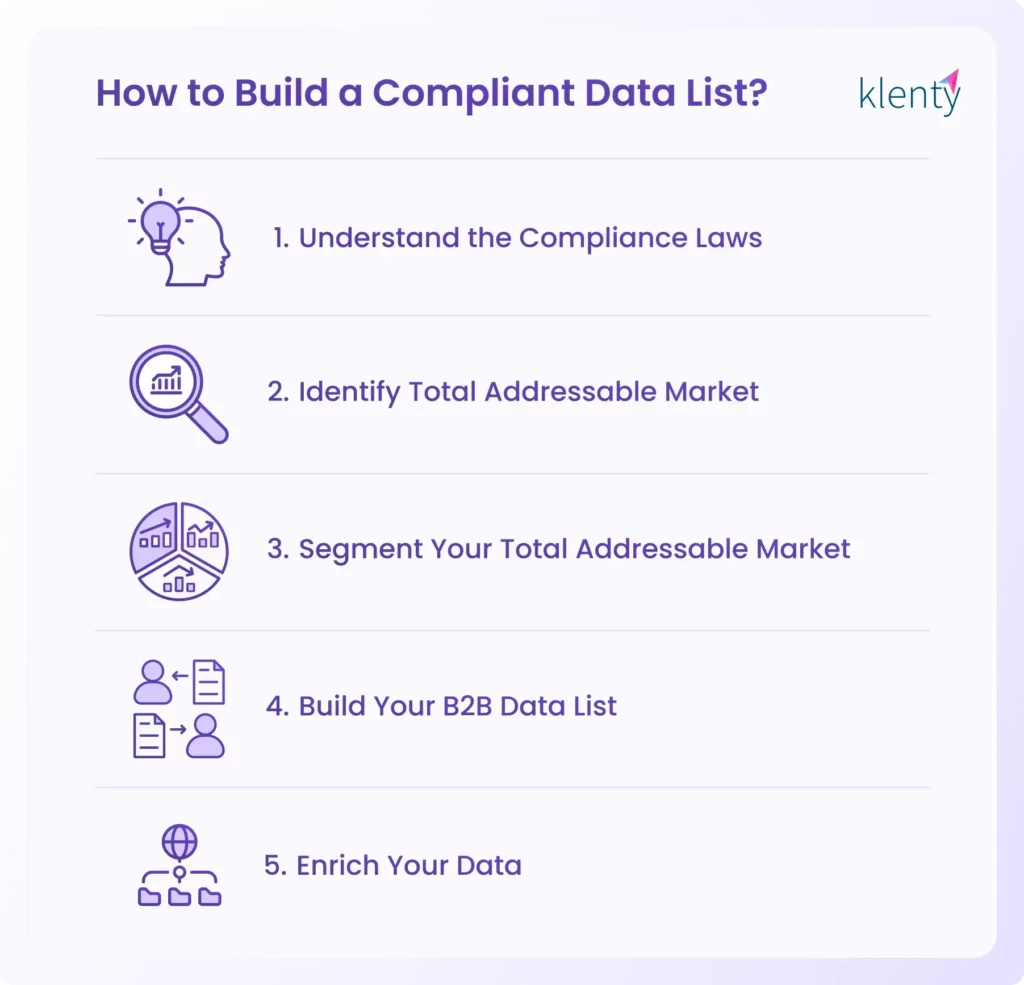
1. Understand the Compliance Laws
It probably goes without saying, but the first step in creating a compliant B2B data list is understanding the various compliance laws and regulations. This includes knowing what constitutes personal data, understanding the rights of individuals under these laws, and being aware of your obligations as a data controller or processor.
💡Suggested reading: IBM’s comprehensive guide on data compliance.
2. Identify Total Addressable Market
Next, calculate your Total Addressable Market (TAM).
TAM refers to the total market demand for a product or service. Simply put, if every possible customer in your specific market segment purchases your solution, how much revenue would your business generate?
There are many ways to calculate TAM, but 2 most popular ones are:
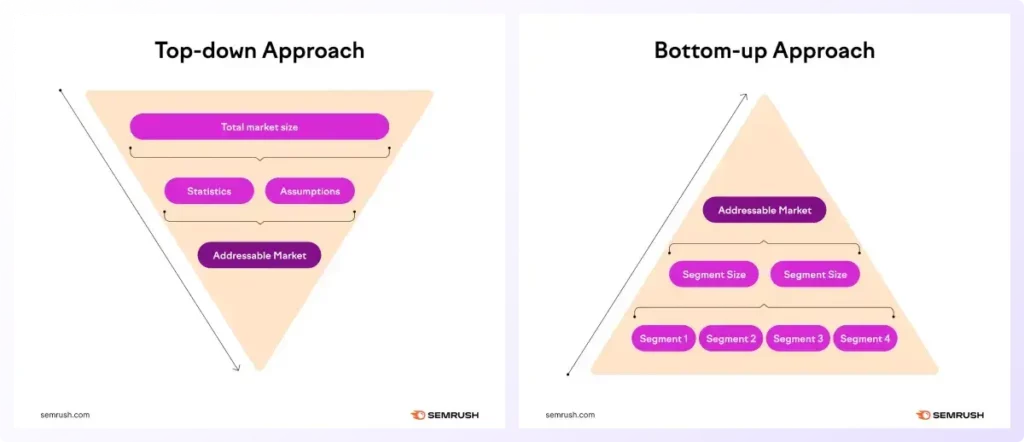
1. Top-Down
The top-down method starts with an overall market estimate through consumer database lists. Then, it refines it by applying filters based on demography, geography, or others to identify a specific market segment. Also note that this approach depends on research from firms like Gartner or Forrester, so the data may only be partially true.
For example, if the total market size for a particular industry is $1 billion and your product targets a segment representing 10% of the total market, your TAM would be $100 million.
2. Bottom-up
The bottom-up approach is used when there is more granular data available. It involves estimating the potential customers in your target market and multiplying this by the average revenue per customer.
For example, if you estimate 1 million potential customers for your product and the average annual revenue per customer is $100, your TAM would be $100 million.
3. Segment Your Total Addressable Market
To build an effective B2B dataset, you need to slice your TAM into easily digestible segments. Segmentation helps you better understand and target specific customers within the large market.
Segmenting your target market by geography can also help you comply with various data compliance laws pertaining to that region. For example, if you’re targeting EU prospects, you must comply with GDPR guidelines, whereas a Californian prospect needs to be contacted with CCPA in mind.
With that, let’s see the different kinds of segmentation:
- Demographics: Divide the market based on demographic factors like age, income, gender, or occupation. For example, Slack tailors its messaging to appeal to different professional roles within organizations—marketing, sales, developers, and customer support teams.
- Geography: For businesses that need to localize their solution, chop your TAM based on region, country, city, or state. For example, McDonald’s caters its menu based on popular regional flavors—like the Teriyaki Burger in Japan and the Picanha Barbecue Bacon burger in Brazil.
- Technographics: Businesses that offer tech products or services may need to segment their TAM based on technology usage, like preferred operating systems, devices, and applications. For example, Salesforce offers migration tools and incentives for customers using competing CRM systems to switch to Salesforce.
- Firmographics: These are the characteristics and attributes used to describe businesses—like industry, company size, location, revenue, and number of employees. They’re demographics applied at a business level. For instance, businesses may position their product differently for mid-market and enterprise companies.
- Psychographics: Here, you would segment people based on attitudes, aspirations, values, lifestyle choices, social status, and opinions. Based on organizational culture, risk tolerance, and attitude toward technology, IBM uses psychographics to slice their products into markets.
These are just a few examples of how you can segment your TAM. You’re free to customize it based on your preferences. Some companies, for instance, prefer segmenting their TAM based on the unique value they provide to each customer segment.
4. Build Your B2B Data List
Once your segments are ready to go, it’s time to build your compliant B2B data list.
When sourcing data, ensure you do so legally and ethically. This means obtaining data from reputable sources that comply with data protection laws. This could include purchasing data from a respected data provider, using publicly available sources such as company websites or directories, or collecting data directly from your website through opt-in forms.
While choosing your B2B data provider, always ensure they meet data compliance standards.
Here’s how you can do so:
- Research the data provider’s reputation and history. Visit review sites, read testimonials, and find news articles or reports about their practices.
- Look for certifications that indicate that they’re data compliant. Most organizations have badges or logos on their website to confirm this.
Pro tip: Read their privacy policy carefully to understand how they collect, store, and use data.
- If you’re still confused, do not hesitate to contact your provider directly. Remember: one wrong move could cost you millions in damages.
- Ask the provider to sign a Data Processing Agreement (DPA) that outlines their data processing practices, responsibilities, and compliance with applicable laws. This document is essential for ensuring they handle data in a compliant manner.
For detailed information on how to build your prospecting list, refer to How to Build a Sales Prospecting List: Expert Tips from 4 Sales Leaders.
5. Enrich Your Data
You should have a fully built, accurate set of prospect details by now.
However, there are chances that a few key details may be missing, like a phone number here or an email address there. Or your prospect could have updated their contact details, which hasn’t been reflected in the data provider yet. This is why it’s important to enrich your data from time to time.
As the name suggests, data enrichment is the process of enhancing your prospect information by filling in or missing gaps or updating outdated information. This improves the effectiveness of your outreach.
Now that your lists are ready, it’s time to double down and make sure your data is accurate and up-to-date.
Sales intelligence tools, like Prospect IQ by Klenty, can help you with enrichment. They identify missing data and automatically populate them with relevant data, with zero intervention from your side. Alternatively, you can even enter a domain name or LinkedIn URL to find complete and accurate email, phone, title, and technographic data.
Leverage a Platform That Builds a Compliant B2B Data List
We know how difficult it is to comply with all laws and regulations. One mistake, and you could be facing up to €20 million in penalties.
That’s why we built Prospect IQ, your data-compliant B2B Prospecting Data Platform.
With Prospect IQ, you can:
- Filter companies based on GDPR and SOC 2 Type II compliance
- Find prospects based on company name, industry, department, revenue size, technologies used, domain name, and so on
- Save your “ICP” or “Best Customer Lookalikes” as Views that can be readily accessed
- Target prospects with unique needs based on demographics, geographic, or technographic data
- Execute a set of personalized activities as soon as you get your hands on their contact data
- Sync all information back to your CRM to keep an updated system of record
What’s most unique about Prospect IQ is its “Waterfall Model” for lead enrichment. Prospect IQ screens over 10+ data providers instead of single-source data platforms and surfaces the best-fit customer information.
Curious to know more about how Prospect IQ can help you build a compliant B2B data list? Contact us to get a tailored demo now!
